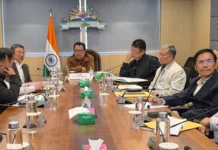ITANAGAR, 31 May: The movement against the proposed 11,500 MW Siang Upper Multipurpose Project (SUMP) by the National Hydroelectric Power Corporation (NHPC) in Arunachal Pradesh has garnered support from 30 NGOs and organizations nationwide.
In a joint press statement, they expressed solidarity with the Siang Indigenous Farmers’ Forum (SIFF), which is spearheading the people’s protest against the project.
They demanded immediate removal of CAPF personnel from Siang, Upper Siang and East Siang districts, immediate withdrawal of the drilling machine from the survey site in Beging, and an assurance from the state government that no further forceful activity related to the PFR would be carried out without the free, prior and informed consent of the local communities.
They also demanded safety for advocate Ebo Mili and other protesters, and the dropping of all charges against them.
They further demanded an immediate halt to SUMP-related activities, dialogue with the local communities, a transparent and
participatory environmental and social review process of the Siang basin, restoration of indigenous land rights, and implementation of the Forest Rights Act in Arunachal. “This would strengthen traditional community forest governance systems and ecologically responsible alternatives to mega hydropower like distributed mini-hydels to meet local electricity requirements,” the organizations said.
The organizations urged the Government of India to explore an equitable water-sharing agreement with China, rather than both countries competitively pursuing mega-hydro projects.
The Siang River, known as Yarlung Tsangpo in Tibet, flows from China into Arunachal before joining the Brahmaputra in Assam.
The SUMP proposes a network of 43 dams across the river and its tributaries, at a cost estimated by the NHPC of Rs 1.13 lakh crore, the statement said.
“For centuries, the Siang River has been the lifeline for the region’s indigenous communities, providing water for their farms and enabling a cultural connection to their ancestors.”
“If implemented, SUMP would submerge extensive tracts of fertile farmland, sacred forests, and traditional hunting grounds, displacing thousands of indigenous families, and disrupting centuries-old agricultural and ecological systems,” they said.
The SIFF says at least 27 villages in Siang and Upper Siang districts would be directly impacted by the dam. People from the Adi community say that their language, forest, rivers, culture, tradition, and identity would perish.
The basin is rich in forest biodiversity.
“More than 82% of the Siang basin (more than 15,000 sq km) is under forest cover, rich in orchids, rhododendrons, bamboo and canes; overall, 27 rare, endangered and threatened (RET) and 46 endemic plant species.”
“Twenty-five mammalian species found such as the red panda and clouded leopard are under Schedule I of the Wildlife Protection Act, facing the highest threat of extinction, while 26 are under Schedule II.”
“There are 447 species of birds, of which 31 are Schedule I species. The basin consists of 5 important bird and biodiversity areas (IBA), vital for conservation of bird populations of species like hornbills,” the statement read.
They said: “The Siang river basin study submitted in 2013 as part of the EIA had said that if all the proposed 43 dams on the river were built, of its total course in India, only 85.5 kms (29%) of the free-flowing water regime of the Siang River would be left.”
They further said that implementation of SUMP will accelerate deforestation, degrade river ecosystems, and disturb the region’s flora and fauna.
According to the statement, altering the natural flow of the Siang River is expected to alter the entire Siang River’s aquatic system, which would adversely impact the aquatic biodiversity and disrupt the breeding patterns of native fish species (many of which migrate upstream during specific seasons), deplete aquifers and groundwater levels, affecting agriculture and potable water access, cause irreversible damage to the habitat of endangered species and increase the risk of landslides and flash floods in an already fragile mountain terrain.
Located in Seismic Zone V, the area is prone to powerful earthquakes, which could compromise the dam’s structural integrity and lead to catastrophic flooding downstream in Assam, they said.
Additionally, the fragile mountainous terrain increases the likelihood of landslides, which can cause sedimentation, disrupt river ecosystems, and threaten local communities, the statement said.
Climate change is causing Himalayan glaciers in Arunachal to melt at an alarming rate, further increasing the dangers of floods and mudflows, which can also cause dam bursts and flooding downstream.
The SUMP has been justified by the union and the state governments as a necessary countermeasure to China’s proposed 66-GW hydropower project in the upper course of the Siang.
It has been argued that the SUMP would maintain the natural flow of the Siang River and mitigate potential flood risks from water releases by China.
“But our past experience from Kerala in 2018, Uttarakhand in multiple years and Sikkim in 2023 has shown that hydropower-based big dams have caused bigger floods, rather than mitigate flood risks.”
The state government sees hydropower as a major source of revenue for the state, without considering the social and environmental impact of dam projects.
“The hydropower projects in the state, including SUMP, lack transparency, as key information such as environmental impact assessments and social impact analysis has not been disclosed to local communities in an accessible manner. Public hearings held by the government have been designed to assert its own plans rather than hear from the public. The input and demands of community representatives have been ignored or dismissed by the government,” the organizations added.
The signatories of the solidarity groups were the National Alliance of People’s Movements, National Alliance for Climate and Ecological Justice, Campaign to Defend Nature and People, Affected Citizens of Teesta, Sikkim, Climate Front India, Jammu & Kashmir, Youth for Himalaya, Himachal Pradesh, Chalakudypuzha Samrakshana Samiti, Kerala, Sir JC Bose Science Heritage Museum, West Bengal, South Asia Network on Dams, Rivers and People, New Delhi, Nodi Bachao Jibon Bachao Andolan, West Bengal, Chennai Climate Action Group, Tamil Nadu, All India Inquilabi Youth and Students Alliance, People for Aravallis, Haryana, Mehanati Publication, West Bengal, Manipur Nature Society, Indian Community Activists Network – Maharashtra, Jagrit Adivasi Dalit Sangathan, Madhya Pradesh, Bargi Dam Oustees Organization, Madhya Pradesh, All India Feminist Alliance, Kosi Nav Nirman Manch, Bihar, Nadi Ghati Morcha, Bharat Jan Vigyan Jatha, Queers for Constitution, New Delhi, CPI (ML) Liberation, Maharashtra Small Scale Traditional Fish Workers Union, J&K RTI Movement, Jammu & Kashmir, Kalpavriksh, Maharashtra, Caste Annihilation Front, Tamil Nadu, Aashray Abhiyan, Bihar, and Eco Warriors Nagaland.



